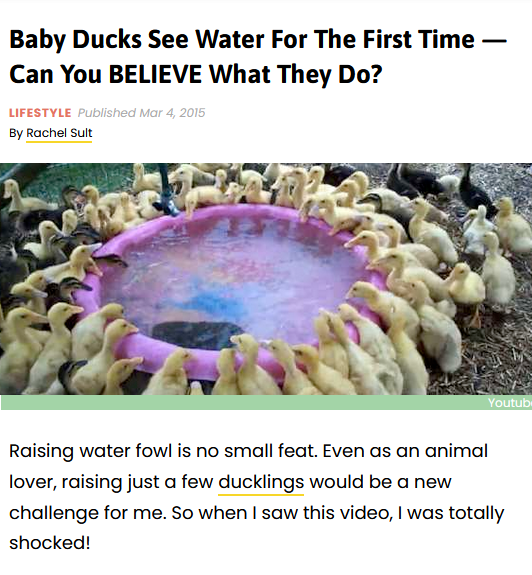[ad_1]
What makes engaging titles so clickable?
A catchy headline you can’t resist to click?
Great news: The answer doesn’t live in a pot of gold at the end of a rainbow.
Actually, it’s more scientific.
And in this post, we’ll break it down with 11 proven ways to make your titles magnetic.
Keep reading to learn all about them.
11 Ways to Create Engaging Titles That Grab Your Readers’ Attention
Here’s the list of effective ways to craft engaging titles that your audience will find irresistible.
1. Use Numbers (Odd is Best?)
Studies show that numbers in titles get the most clicks.
Just look at this chart from a study done by Conductor:
That’s 36% of people prefer titles with numbers in, 15% higher than the 2nd preference, “reader-addressing.”
Readers like numbers because they like lists. It tells them how many components they can expect to see.
Studies also show that odd numbers do better than even numbers.
Why?
Because people trust odd numbers. They assume that more items could not be added or removed from the list.
That’s because we generally think even numbers are better and more convenient.
So if the title has an odd number, it must be more accurate.
Of course, it’s fine to use even numbers if the blog post calls for it; just remember that odd numbers in titles result in higher engagement rates.
And don’t just stick to numbered headlines. Mix it up to provide variety, such as how-to posts, questions, and general posts.
2. Use Power Words
Writing engaging titles for your blog posts means that it will stand out from the rest.
You’re competing with nine other search engine results. And hundreds of posts that people scroll past in their social media feeds.
You can use a power word to get them to pause (and click).
Power words for blog titles are an effective way to draw readers in and get them to click on your content.
That’s because power words evoke strong emotions and create a vivid mental image.
You don’t need to resort to clickbait tactics and offer false promises.
Just enough to pique their interest and get them excited to read your article.
Some effective power words include:
- Powerful
- Surprising
- Amazing
- Unbelievable
- Mind-blowing
- Exclusive
These words that add flavor to engaging titles are adjectives.
Adjectives are descriptive words like fantastic, unforgettable, and captivating.
They generate stronger feelings and spur readers into action by making them emotionally curious about what’s beyond the catchy title.
3. Add a Question

Good titles ask questions and can be highly effective at getting the click. Especially if your target audience is asking the same questions.
Also, if the question implies your post will solve one of their problems, your conversions will be higher.
To write question headlines, make sure they can’t directly answer “yes” or “no” to the question, or they won’t click.
Instead, go for questions that require them to actually read your content.
For example:
“Are You Making These Common Serve Mistakes in Your Tennis Game?”
Or
“How Do You Know When It’s Time to Replace Your Dog’s Food Bowl?”
Another great question to ask in your titles is the “Who Else Wants [Something]” formula.
Here are a few to start you off:
- “Who Else Wants to Live an Extra 7 Years? These Studies Explain How”
- “Who Else Wants to Start an Online Business Using Only ChatGPT?”
- “Who Else Wants More Traffic by Changing These 3 Things?”
4. Sell the Experience
They say that benefits are better than features, but what’s better than benefits?
The experience!
Benefits and the experience of what the benefits offer are subtle. But, describing the experience can oftentimes make all the difference.
Here are two examples:
- Benefit driven: These 7 Adjustable Dumbbells Will Save You Space at Home
- Experience driven: 5 Ways Adjustable Dumbbells Make it Easier to Build Muscle
The first title focuses on the space adjustable dumbbells provide in the home. A clear benefit.
The second title sells you on the experience, claiming that it’s easier to build muscle with adjustable dumbbells.
This also adds an element of curiosity, killing two birds with one stone.
We’ll talk more about curiosity later.
5. Poke at The Pain
Another excellent way to create engaging titles is to prod and poke at a pain point.
Highlighting pain points is much more effective at converting readers than selling on pleasures.
That’s because people are twice as motivated by pain than by pleasure.
And you can use this to your advantage for a more engaging headline.
Look at these titles, for example:
- 9 Blogging Mistakes You’re Making and How to Fix Them
- 5 Reasons Your Garage Isn’t Safe From Thieves
The first title raises concerns about bloggers making mistakes. This will certainly get their attention.
The second example suggests the readers’ garage might not be safe. They will definitely want to read the article to find out why.
6. Be Specific
Being specific in your headlines is a powerful way to build credibility and authority.
The more specific you are, the more you’ll be perceived as an expert in your niche.
In fact, there are copywriting frameworks that include Specificity within them.
Such as the 4 U’s formula:
- Urgency
- Uniqueness
- Usefulness
- Ultra-Specificity
Ultra-Specificity says that headlines, content, emails, and ads, should be ultra-specific because it converts better than generic copy.
Another is the 5 S’s:
- Solicitude
- Selflessness
- Specificity
- Stickiness
- Solidarity
Specificity in this formula mirrors the first one. Readers are more likely to trust you the more specific you are about the problems you can solve.
Here’s an example to make titles more engaging:
- Generic: “5 Ways to Use the Keto Diet for Brain Health”
- Specific: “Keto Diet and The Brain: How to Use Keto to Improve Mood and Cognitive Performance”
- Generic: “Keto Meal Prep: How to Plan and Prepare Your Week’s Meals”
- Specific: “Keto Meal Prep 101: Plan and Prep a Week of Keto Meals in Under 3 Hours”
7. Use the Date

Using the date in your titles tells the potential reader the content is up-to-date and accurate.
It can also signal trust because of your dedication to only providing the best information.
This is much more important depending on the niche you’re in or the topic you’re writing about.
For example, the blog post title “Follow this Morning Routine for Ultra Productivity” doesn’t really need a date because it’s classed as evergreen.
But one about the latest Black Friday deals is essential.
To automate this process, use the dynamic title variable in the SEO plugin you use.
In Rank Math, this looks like %current_year%, and in Yoast, it’s %%currentyear%%.
If your article is super competitive, consider adding the month to the title for extra perceived freshness.
Just make sure you go into the posts and update them when it makes sense to do so.
8. Combat Objections
One of the biggest barriers in sales is effectively handling objections.
And objections might even deter people from reading your blog posts.
The most common objections include:
- It’s too expensive
- I’m not ready to buy it yet
- I don’t have the time
- It’s too hard to use/learn
So if your article title can put people off because they have objections, try to overcome them in the title itself.
Like this:
- It’s too expensive objection: 7 Best Robot Vacuums for Pets Under $100
- I’m not ready to buy yet objection: How to Choose the Best Luggage as a Digital Nomad (And Stress Less Before You Travel)
- I don’t have the time objection: 9 Juicing Recipes That Take 10 Minutes (Or Less!)
- It’s too hard to learn objection: 9 Blogger Tips for Complete Beginners
9. Use Curiosity
Writing titles that encourage curiosity is a great way to get more eyeballs on your content.
And more eyeballs mean more traffic, more subscribers, and more income.
But you don’t need to rely on clickbait titles like this:

(All they do is drink the water.)
Want to know how to create curiosity without cringy clickbait?
Use titles like this:
- These 3 Dog Leads are Selling Like Crazy – Here’s Why
- How I Got 473% More Blog Traffic by Doing This One Thing
Here are a few guidelines to follow:
- Make a bold claim. Don’t be afraid to brag a little if you have achieved something significant.
- Don’t give everything away in the blog title. Like the above dog leads title. People want to know why they’re selling, but it could be because of the impressive features all dog owners would love.
- Use intrigue to encourage people to want to find out more.
- Always deliver in your post. If you don’t, people will stop trusting you to deliver great content.
10. Make a Promise

This one ties into many of the other tips in this post, but it holds its own merits, so it deserves its own spot.
A promise in a blog title is simply something the reader with leave with if they read the content.
Now, most titles will imply this, but you can make them even more appealing by including specifics.
For example:
- Without a promise: 11 Simple Steps to Self-Publish Your First Kindle Book
- With a promise: 11 Steps to Self Publish a Book on Amazon in Less Than 5 Days
And another
- Without a promise: 7 Ways to Speed Up Your WordPress Site
- With a promise: 7 Ways to Speed Up WordPress and Increase Organic Traffic
See how both examples add a super valuable promise at the end.
Not only will they learn about the main topic, but there’s something extra that makes it better.
Give it a try.
11. Test Different Versions
This last tip isn’t about writing engaging titles but testing them instead.
Also known as AB testing, it’s where you use a tool or service to see which titles perform better.
When you use the tips in this post, you might see a spike in traffic and CTR, but unless you track your title’s performance, you won’t know how to improve.
To start AB testing headlines in WordPress, you can use a premium plugin and service called Nelio A/B Testing.
Another option is Google Optimize which integrates with Google Analytics and is free for five simultaneous experiments.
You can then add interesting title variations to your posts, and the tools will tell you which performs better.
Conclusion: How to Write Engaging Titles with Ease
Now you know how to write highly engaging titles, how can you quickly tell if they’ll measure up?
You can use this headline analyzer tool by CoSchedule. It gives you a score for some immediate feedback.
Other than that, these 11 tips will drastically improve your click-through rates and the readership of your blog.
[ad_2]
Source link









